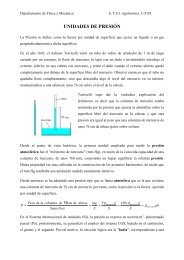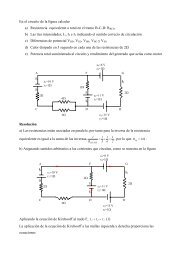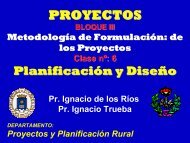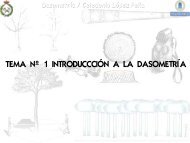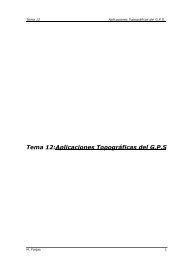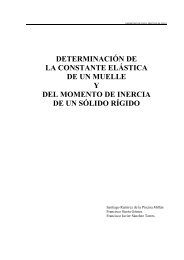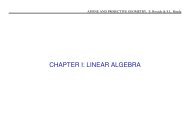CHAPTER II: AFFINE AND EUCLIDEAN GEOMETRY - OCW UPM
CHAPTER II: AFFINE AND EUCLIDEAN GEOMETRY - OCW UPM
CHAPTER II: AFFINE AND EUCLIDEAN GEOMETRY - OCW UPM
You also want an ePaper? Increase the reach of your titles
YUMPU automatically turns print PDFs into web optimized ePapers that Google loves.
<strong>AFFINE</strong> <strong>AND</strong> PROJECTIVE <strong>GEOMETRY</strong>, E. Rosado & S.L. Rueda<br />
<strong>CHAPTER</strong> <strong>II</strong>: <strong>AFFINE</strong> <strong>AND</strong> <strong>EUCLIDEAN</strong> <strong>GEOMETRY</strong>
<strong>AFFINE</strong> <strong>AND</strong> PROJECTIVE <strong>GEOMETRY</strong>, E. Rosado & S.L. Rueda<br />
2. <strong>AFFINE</strong> TRANSFORMATIONS<br />
2.1 Definition and first properties<br />
Definition<br />
Let (A, V, φ) and (A ′ , V ′ , φ ′ ) be two real affine spaces. We will say that a map<br />
f : A −→ A ′<br />
is an affine transformation if there exists a linear transformation ¯f : V −→ V ′<br />
such that:<br />
¯f(P Q) = f (P ) f (Q), ∀P, Q ∈ A.<br />
This is equivalent to say that for every P ∈ A and every vector ū ∈ V we<br />
have<br />
f(P + u) = f(P ) + ¯f(u).<br />
We call ¯f the linear transformation associated to f.
<strong>AFFINE</strong> <strong>AND</strong> PROJECTIVE <strong>GEOMETRY</strong>, E. Rosado & S.L. Rueda<br />
Proposition<br />
Let (A, V, φ) and (A ′ , V ′ , φ ′ ) be two affine subspaces and let f : A −→ A ′ be an affine<br />
transformation with associated linear transformation ¯f : V −→ V ′ . The following statements<br />
hold:<br />
1. f is injective if and only if ¯f is injective.<br />
2. f is surjective if and only if ¯f is surjective.<br />
3. f is bijective if and only if ¯f is bijective.<br />
Proposition<br />
Let g : A −→ A ′ and f : A ′ −→ A ′′ be two affine transformations. The composition f ◦<br />
g : A −→ A ′′ is also an affine transformation and its associated linear transformation is<br />
f ◦ g = ¯f ◦ ḡ.<br />
Proposition<br />
Let f, g : A −→ A ′ be two affine transformations which coincide over a point P , f(P ) =<br />
g(P ), and which have the same associated linear transformation ¯f = ḡ. Then f = g.<br />
Proof<br />
Every X ∈ A verifies:<br />
f(X) = f(P + P X) = f(P ) + ¯f(P X) = g(P ) + ḡ(P X) = g(X).
<strong>AFFINE</strong> <strong>AND</strong> PROJECTIVE <strong>GEOMETRY</strong>, E. Rosado & S.L. Rueda<br />
2.2 Matrix associated to an affine transformation<br />
Let (A, V, φ) and (A ′ , V ′ , φ ′ ) be two affine subspaces and let f : A −→ A ′ be<br />
an affine transformation with associated linear transformation ¯f : V −→ V ′ .<br />
We consider affine coordinate systems R = {O; B}, B = {e 1 , . . . , e n } and<br />
R ′ = {O ′ ; B ′ }, B ′ = {e ′ 1, . . . , e ′ m} of the spaces A, A ′ respectively. Let us<br />
assume that:<br />
O ′ f(O) = b 1 e ′ 1 + · · · + b m e ′<br />
⎧<br />
m,<br />
⎨ ¯f(e 1 ) = a 11 e ′ 1 + · · · + a m1 e ′ m<br />
.<br />
⎩ ¯f(e n ) = a 1n e ′ 1 + · · · + a mn e ′ m<br />
Let P be the point with coordinates (x 1 , . . . , x n ) with respect to R and let<br />
(y 1 , . . . , y m ) be the coordinates of f(P ) ∈ A ′ .
Then:<br />
We will write<br />
⎛<br />
⎜<br />
⎝<br />
M f (R, R ′ ) =<br />
⎞ ⎛<br />
1<br />
y 1<br />
⎟<br />
. ⎠ = ⎜<br />
⎝<br />
y m<br />
(<br />
1 0<br />
t<br />
<strong>AFFINE</strong> <strong>AND</strong> PROJECTIVE <strong>GEOMETRY</strong>, E. Rosado & S.L. Rueda<br />
⎞ ⎛<br />
1 0 · · · 0<br />
b 1 a 11 · · · a 1n<br />
⎟ ⎜<br />
. .<br />
... . ⎠ ⎝<br />
b m a m1 · · · a mn<br />
b M ¯f(B, B ′ )<br />
)<br />
=<br />
⎛<br />
⎜<br />
⎝<br />
⎞<br />
1<br />
x 1<br />
⎟<br />
. ⎠<br />
x n<br />
⎞<br />
1 0 · · · 0<br />
b 1 a 11 · · · a 1n<br />
⎟<br />
. .<br />
... . ⎠<br />
b m a m1 · · · a mn<br />
where b are the coordinates of f(O) in the coordinate system R ′ and M ¯f(B, B ′ )<br />
is the matrix associated to the linear transformation ¯f taking in V the basis<br />
B and in V ′ the basis B ′ .
<strong>AFFINE</strong> <strong>AND</strong> PROJECTIVE <strong>GEOMETRY</strong>, E. Rosado & S.L. Rueda<br />
Example 1<br />
Let (A, V, φ) be an affine space with affine coordinate system R = {O; B =<br />
{e 1 , e 2 , e 3 }}, and let (A ′ , V ′ , φ ′ ) be an affine space with affine coordinate system<br />
R ′ = {O ′ ; B ′ = {e ′ 1, e ′ 2}}. Is the transformation f : A −→ A ′ , f(x, y, z) =<br />
(x − 2y + 5, x − z + 1) an affine transformation? Give its associated linear<br />
transformation and obtain the matrix associated to f in the coordinate systems<br />
R, R ′ .<br />
Solution.<br />
To see if f is an affine transformation we have to check if there exists a<br />
linear transformation ¯f : V −→ V ′ such that f(P )f(Q) = ¯f ( P Q ) for every<br />
pair of points P, Q ∈ A. We take P (x 1 , y 1 , z 1 ) and Q(x 2 , y 2 , z 2 ) then<br />
and<br />
P Q = Q − P = (x 2 − x 1 , y 2 − y 1 , z 2 − z 1 )
<strong>AFFINE</strong> <strong>AND</strong> PROJECTIVE <strong>GEOMETRY</strong>, E. Rosado & S.L. Rueda<br />
f(P )f(Q) = f(Q) − f(P ) = f(x 2 , y 2 , z 2 ) − f(x 1 , y 1 , z 1 )<br />
= (x 2 − 2y 2 + 5, x 2 − z 2 + 1) − (x 1 − 2y 1 + 5, x 1 − z 1 + 1)<br />
= ((x 2 − x 1 ) − 2 (y 2 − y 1 ) , (x 2 − x 1 ) − (z 2 − z 1 ))<br />
= ¯f (x 2 − x 1 , y 2 − y 1 , z 2 − z 1 ) .<br />
Therefore, f is an affine transformation and its associated linear transformation<br />
is ¯f (x, y, z) = (x − 2y, x − z).<br />
The coordinates of the origin O in the coordinate system R are the cooordinates<br />
of the vector OO = (0, 0, 0) in the basis B where e 1 = (1, 0, 0) B ,<br />
e 2 = (0, 1, 0) B and e 3 = (0, 0, 1) B .
Then:<br />
<strong>AFFINE</strong> <strong>AND</strong> PROJECTIVE <strong>GEOMETRY</strong>, E. Rosado & S.L. Rueda<br />
f(O) = f(0, 0, 0) = (5, 1),<br />
¯f(e 1 ) = ¯f(1, 0, 0) = (1, 1),<br />
¯f(e 2 ) = ¯f(0, 1, 0) = (−2, 0),<br />
¯f(e 3 ) = ¯f(0, 0, 1) = (0, −1).<br />
So,<br />
M f (R, R ′ ) =<br />
⎛<br />
⎝<br />
1 0 0 0<br />
5 1 −2 0<br />
1 1 0 −1<br />
⎞<br />
⎠ .
<strong>AFFINE</strong> <strong>AND</strong> PROJECTIVE <strong>GEOMETRY</strong>, E. Rosado & S.L. Rueda<br />
Example 2<br />
Let (A, V, φ) be an affine space with affine coordinate system R = {O; B =<br />
{e 1 , e 2 }}, and let (A ′ , V ′ , φ ′ ) be an affine space with affine coordinate system<br />
R ′ = {O ′ ; B ′ = {e ′ 1, e ′ 2, e ′ 3}}. Determine the affine transformation f : A −→<br />
A ′ , such that<br />
f(1, 2) = (1, 2, 3),<br />
¯f(e 1 ) = e ′ 1 + 4e ′ 2,<br />
¯f(e 2 ) = e ′ 1 − e ′ 2 + e ′ 3.<br />
Find the matrix associated to f in the coordinate systems R, R ′ .<br />
Solution.<br />
We know the value of f at the point P (1, 2) and the linear transformation<br />
associated to f, therefore we can determine f.<br />
¯f(1, 0) = (1, 4, 0) B ′,<br />
¯f(0, 1) = (1, −1, 1) B ′,
<strong>AFFINE</strong> <strong>AND</strong> PROJECTIVE <strong>GEOMETRY</strong>, E. Rosado & S.L. Rueda<br />
To calculate the matrix associated to f we need to compute f(O). We have:<br />
so<br />
f(P ) =<br />
f is affine f(O) + ¯f(OP ) = f(O) + ¯f(1e 1 + 2e 2 )<br />
=<br />
¯f is linear<br />
f(O) + ¯f(e 1 ) + 2 ¯f(e 2 )<br />
= f(O) + (1, 4, 0) + 2(1, −1, 1)<br />
f(O) = f(1, 2) − (1, 4, 0) − 2(1, −1, 1)<br />
= (1, 2, 3) − (1, 4, 0) − 2(1, −1, 1)<br />
= (−2, 0, 1) .<br />
therefore<br />
M f (R, R ′ ) =<br />
⎛<br />
⎜<br />
⎝<br />
1 0 0<br />
−2 1 1<br />
0 4 −1<br />
1 0 1<br />
⎞<br />
⎟<br />
⎠ .
As<br />
we have:<br />
⎛<br />
⎜<br />
⎝<br />
1 0 0<br />
−2 1 1<br />
0 4 −1<br />
1 0 1<br />
<strong>AFFINE</strong> <strong>AND</strong> PROJECTIVE <strong>GEOMETRY</strong>, E. Rosado & S.L. Rueda<br />
⎞<br />
⎛<br />
⎟ ⎝<br />
⎠<br />
⎛<br />
⎞<br />
1<br />
x 1<br />
⎠ = ⎜<br />
⎝<br />
x 2<br />
1<br />
x 1 + x 2 − 2<br />
4x 1 − x 2<br />
x 2 + 1<br />
f(x 1 , x 2 ) = (x 1 + x 2 − 2, 4x 1 − x 2 , x 2 + 1) .<br />
⎞<br />
⎟<br />
⎠
<strong>AFFINE</strong> <strong>AND</strong> PROJECTIVE <strong>GEOMETRY</strong>, E. Rosado & S.L. Rueda<br />
Example 3<br />
Let (R 2 , R 2 , φ) be an affine space with affine coordinate system R = {O; B =<br />
{e 1 , e 2 }}. Determine the affine transformation f : R 2 −→ R 2 such that<br />
f(1, 1) = (7, 5), f(1, 2) = (11, 4), f(2, 1) = (8, 8).<br />
Solution.<br />
To give an affine transformation f : R 2 −→ R 2 we need three points that<br />
form an affine coordinate system and their images.<br />
First method<br />
Since P 0 P 1 = (0, 1) and P 0 P 2 = (1, 0) , then we know that<br />
¯f(e 1 ) = ¯f(1, 0) = ¯f(P 0 P 2 ) = f(P 2 ) − f(P 0 ) = (1, 3),<br />
¯f(e 2 ) = ¯f(0, 1) = ¯f(P 0 P 1 ) = f(P 1 ) − f(P 0 ) = (4, −1).<br />
Also OP 0 = e 1 + e 2 so we have:<br />
f(P 0 ) = f(O) + ¯f(OP 0 ) = f(O) + ¯f(e 1 + e 2 )<br />
= f(O) + ¯f(e 1 ) + ¯f(e 2 )
then<br />
<strong>AFFINE</strong> <strong>AND</strong> PROJECTIVE <strong>GEOMETRY</strong>, E. Rosado & S.L. Rueda<br />
finally,<br />
f(O) = f(P 0 ) − ¯f(e 1 ) − ¯f(e 2 ) = (7, 5) − (1, 3) − (4, −1)<br />
= (2, 3).<br />
M f (R, R) =<br />
and f(x 1 , x 2 ) = (2 + x 1 + 4x 2 , 3 + 3x 1 − x 2 ).<br />
Second method<br />
⎛<br />
⎝<br />
1 0 0<br />
2 1 4<br />
3 3 −1<br />
The set R ′ = {P 0 (1, 1), P 1 (1, 2), P 2 (2, 1)} is an affine coordinate system since<br />
P 0 P 1 = (0, 1) and P 0 P 2 = (1, 0) is a basis of R 2 . We have:<br />
f(P 0 ) = f(1, 1) = (7, 5),<br />
¯f(P 0 P 1 ) = f(P 0 )f(P 1 ) = f(P 1 ) − f(P 0 ) = (11, 4) − (7, 5) = (4, −1),<br />
¯f(P 0 P 2 ) = f(P 0 )f(P 2 ) = f(P 2 ) − f(P 0 ) = (8, 8) − (7, 5) = (1, 3).<br />
⎞<br />
⎠
Therefore,<br />
M f (R, R ′ ) =<br />
<strong>AFFINE</strong> <strong>AND</strong> PROJECTIVE <strong>GEOMETRY</strong>, E. Rosado & S.L. Rueda<br />
⎛<br />
⎝<br />
1 0 0<br />
7 4 1<br />
5 −1 3<br />
To obtain M f (R, R), we are going to change the coordinate system from R ′<br />
to R:<br />
M f (R, R) = M f (R ′ , R)M(R, R ′ ) = M f (R ′ , R)M(R ′ , R) −1<br />
⎛ ⎞ ⎛ ⎞−1<br />
⎛ ⎞<br />
1 0 0 1 0 0 1 0 0<br />
= ⎝ 7 4 1 ⎠ ⎝ 1 0 1 ⎠ = ⎝ 2 1 4 ⎠<br />
5 −1 3 1 1 0 3 3 −1<br />
Therefore f(x 1 , x 2 ) = (2 + x 1 + 4x 2 , 3 + 3x 1 − x 2 ).<br />
⎞<br />
⎠
<strong>AFFINE</strong> <strong>AND</strong> PROJECTIVE <strong>GEOMETRY</strong>, E. Rosado & S.L. Rueda<br />
Example 4<br />
Determine the affine transformation f : A 3 −→ A 3 which transforms the<br />
points P 0 (0, 0, 0), P 1 (0, 1, 0), P 2 (1, 1, 1) and P 3 (1, 1, 4) in the points Q 0 (2, 0, 2),<br />
Q 1 (2, −1, 1), Q 2 (2, 1, 3) and Q 3 (5, 7, 6) respectively.<br />
Solution.<br />
To give an affine transformation f : A 3 −→ A 3 we will need four points that<br />
form an affine coordinate system and their images.<br />
The set R ′ = {P 0 (0, 0, 0), P 1 (0, 1, 0), P 2 (1, 1, 1), P 3 (1, 1, 4)} is an affine coordinate<br />
system as P 0 P 1 = (0, 1, 0), P 0 P 2 = (1, 1, 1) and P 0 P 3 = (1, 1, 4) is a basis<br />
of R 3 because<br />
dim(P 0 P 1 , P 0 P 2 , P 0 P 3 ) = 3.
We have:<br />
f(P 0 ) = Q 0 = (2, 0, 0),<br />
¯f(P 0 P 1 ) = f(P 0 )f(P 1 ) = f(P 1 ) − f(P 0 ) = Q 1 − Q 0 = (0, −1, −1),<br />
¯f(P 0 P 2 ) = f(P 0 )f(P 2 ) = f(P 2 ) − f(P 0 ) = Q 2 − Q 0 = (0, 1, 1),<br />
¯f(P 0 P 3 ) = f(P 0 )f(P 3 ) = f(P 3 ) − f(P 0 ) = Q 3 − Q 0 = (3, 7, 4).<br />
Therefore<br />
M f (R ′ , R) =<br />
⎛<br />
⎜<br />
⎝<br />
1 0 0 0<br />
2 0 0 3<br />
0 −1 1 7<br />
0 −1 1 4<br />
⎞<br />
⎟<br />
⎠
<strong>AFFINE</strong> <strong>AND</strong> PROJECTIVE <strong>GEOMETRY</strong>, E. Rosado & S.L. Rueda<br />
To obtain M f (R, R), we are going to change the coordinate system from R ′<br />
to R:<br />
M f (R, R) = M f (R ′ , R)M(R, R ′ ) =<br />
⎛ ⎞ ⎛<br />
1 0 0 0 1 0 0 0<br />
2 0 0 3<br />
0 0 1 1<br />
= ⎜ ⎟ ⎜<br />
⎝ 0 −1 1 7 ⎠ ⎝ 0 1 1 1<br />
0 −1 1 4 0 0 1 4<br />
=<br />
⎛<br />
⎜<br />
⎝<br />
1 0 0 0<br />
2 −1 0 1<br />
0 0 −1 2<br />
0 1 −1 1<br />
Thus, f(x 1 , x 2 , x 3 ) = (2 − x 1 + x 3 , −x 2 + 2x 3 , x 1 − x 2 + x 3 ).<br />
⎞<br />
⎟<br />
⎠<br />
⎞<br />
⎟<br />
⎠<br />
−1
2.3 Affine invariant subspaces<br />
<strong>AFFINE</strong> <strong>AND</strong> PROJECTIVE <strong>GEOMETRY</strong>, E. Rosado & S.L. Rueda<br />
Proposition<br />
Let (A, V, φ) and (A ′ , V ′ , φ ′ ) two affine spaces and let f : A −→ A ′ be an<br />
affine transformation with associated linear transformation ¯f : V −→ V ′ .<br />
The following statements hold:<br />
1. If L ⊂ A is an affine subspace of A then<br />
f(L) = {P ′ ∈ A ′ | there exists P ∈ L such that f(P ) = P ′ }<br />
is an affine subspace of A ′ .<br />
2. If L ′ ⊂ A ′ is an affine subspace of A ′ then the set<br />
L = {P ∈ A | f(P ) ∈ L ′ }<br />
is an affine subspace of A, called the inverse image of L ′ and denoted<br />
f −1 (L ′ ).<br />
Definition<br />
Let (A, V, φ) be an affine space and f : A −→ A an affine transformation.<br />
We will say that a point P ∈ A is a fixed point of f if f(P ) = P .
<strong>AFFINE</strong> <strong>AND</strong> PROJECTIVE <strong>GEOMETRY</strong>, E. Rosado & S.L. Rueda<br />
Proposition<br />
Let (A, V, φ) be an affine space and f : A −→ A an affine transformation.<br />
The set of fixed points of f; this is,<br />
F = {X ∈ A | f(X) = X}<br />
is an affine subspace of A with associated vector space the subspace of V<br />
of eigenvectors of ¯f associated to the eigenvalue λ = 1.<br />
Strategy to search for fixed points<br />
Let (A, V, φ) be an affine space, f : A −→ A an affine transformation, and<br />
R = {O; B} a coordinate system of A. Let<br />
( t )<br />
1 0<br />
M f (R) =<br />
b A<br />
be the matrix associated to f, where A is the matrix associated to the linear<br />
transformation ¯f in the basis B.
<strong>AFFINE</strong> <strong>AND</strong> PROJECTIVE <strong>GEOMETRY</strong>, E. Rosado & S.L. Rueda<br />
If P is a fixed point, the following statement holds:<br />
or equivalently,<br />
P = f(P ) = f(O + OP ) = f(O) + ¯f(OP )<br />
= b + A · OP<br />
0 = (A − I) OP + b<br />
which is the equation that the fixed points of f must satisfy.<br />
Example<br />
Obtain the fixed points of the affine transformation<br />
f(x, y) = (−2y + 1, x + 3y − 1).<br />
Solution.<br />
The matrix associated to f is<br />
M f (R, R) =<br />
⎛<br />
⎝<br />
1 0 0<br />
1 0 −2<br />
−1 1 3<br />
⎞<br />
⎠
<strong>AFFINE</strong> <strong>AND</strong> PROJECTIVE <strong>GEOMETRY</strong>, E. Rosado & S.L. Rueda<br />
and the matrix associated to the linear transformation ¯f is<br />
( ) 0 −2<br />
A = .<br />
1 3<br />
The fixed points of f are the solutions P (x, y) of the following matrix equation:<br />
0 = (A − I) P + b<br />
this is<br />
( 0<br />
0<br />
)<br />
=<br />
( −1 −2<br />
1 2<br />
) ( ) ( )<br />
x 1<br />
+ ⇐⇒ x + 2y − 1 = 0<br />
y −1<br />
Therefore, the points of the line x + 2y − 1 = 0 are the fixed points of f.
<strong>AFFINE</strong> <strong>AND</strong> PROJECTIVE <strong>GEOMETRY</strong>, E. Rosado & S.L. Rueda<br />
Definition<br />
Let (A, V, φ) be an affine space, f : A −→ A an affine transformation and S<br />
an affine subspace of A. We will say that S is an invariant affine subspace<br />
of f if f(S) ⊂ S.<br />
Observation<br />
Let f : A −→ A be an affine transformation with associated linear transformation<br />
¯f : V −→ V and S an affine subspace of A, which contains the<br />
point P and whose associated vector space is generated by the vectors<br />
u 1 , . . . , u r ; this is,<br />
S ≡ P + 〈u, . . . , u r 〉 .<br />
Then the affine subspace f(S) contains the point f(P ) and is generated by<br />
the vectors ¯f(u 1 ), . . . , ¯f(u r ); this is,<br />
f(S) = f(P ) + 〈 ¯f(u1 ), . . . , ¯f(u r ) 〉 .
<strong>AFFINE</strong> <strong>AND</strong> PROJECTIVE <strong>GEOMETRY</strong>, E. Rosado & S.L. Rueda<br />
Then S is invariant under f if and only if<br />
1. 〈 f(u 1 ), . . . , ¯f(u r ) 〉 ⊂ 〈u, . . . , u r 〉<br />
2. P f(P ) ∈ 〈u, . . . , u r 〉<br />
In particular, a line r ≡ P + 〈u〉 is invariant under f if and only if<br />
1. 〈 ¯f(u)<br />
〉<br />
⊂ 〈u〉 ⇐⇒ ¯f(u) = λu; this is , ū is an eigenvector of the linear<br />
transformation ¯f<br />
2. P f(P ) ∈ 〈u〉
<strong>AFFINE</strong> <strong>AND</strong> PROJECTIVE <strong>GEOMETRY</strong>, E. Rosado & S.L. Rueda<br />
Example<br />
Obtain the invariant subspaces of the transformation f of the former example.<br />
Solution.<br />
To search for the invariant subspaces of f first we compute the eigenvalues<br />
of ¯f. The characteristic polynomial A is<br />
det(A − λI) =<br />
∣ −λ −2<br />
1 3 − λ ∣ = λ2 − 3λ + 2 = (λ − 1) (λ − 2)<br />
and, therefore, the eigenvalues of A are λ = 1, 2.
The corresponding subspaces of eigenvectors of ¯f are<br />
V (1) = { v | (A − 1I)v = 0 }<br />
{<br />
( ) ( ) ( )}<br />
−1 −2 x 0<br />
= (x, y) such that<br />
=<br />
1 2 y 0<br />
= {(x, y) such that x + 2y = 0} = 〈(2, −1)〉<br />
V (2) = { v | (A − 2I)v = 0 }<br />
{<br />
( ) ( ) ( )}<br />
−2 −2 x 0<br />
= (x, y) such that<br />
=<br />
1 1 y 0<br />
= {(x, y) such that x + y = 0} = 〈(1, −1)〉
On the other hand<br />
<strong>AFFINE</strong> <strong>AND</strong> PROJECTIVE <strong>GEOMETRY</strong>, E. Rosado & S.L. Rueda<br />
P f(P ) = f(P ) − P = (−2y + 1, x + 3y − 1) − (x, y)<br />
= (−x − 2y + 1, x + 2y − 1) ∈ V (2)<br />
as the components of vector P f(P ) satisfy the equation of V (2).<br />
Therefore, the lines with associated vector space V (2) = 〈(1, −1)〉 are invariant<br />
lines of f because<br />
¯f(1, −1) = 2(1, −1)<br />
P f(P ) ∈ V (2)<br />
If x+2y−1 = 0 (this is the line of the fixed points of f) then P f(P ) = 0 ∈ V (1).<br />
The line of fixed points, is in particular, an invariant line of f.
<strong>AFFINE</strong> <strong>AND</strong> PROJECTIVE <strong>GEOMETRY</strong>, E. Rosado & S.L. Rueda<br />
Example<br />
Let (A 3 , V, φ) be an affine space and R = {O; {e 1 , e 2 , e 3 }} a coordinate system<br />
of A 3 . Determine the affine transformation f : A 3 −→ A 3 such that the<br />
plane π ≡ x + 2y − z = 1 is a plane of fixed points of f and the vector e 1 is<br />
an eigenvector of ¯f associated to the eigenvalue 3.<br />
Solution.<br />
The plane π is a plane of fixed points, any point of the plane is a fixed<br />
point of f. For example, the point P (1, 0, 0) ∈ π is a fixed point of f; this is,<br />
f(P ) = P . Also, we know that the vectors of the vector subspace associated<br />
to π, this is, vectors from the plane π ≡ x + 2y − z = 0, are eigenvectors<br />
associated to the eigenvalue 1.<br />
For example, for<br />
u = (1, 0, 1) ∈ π,v = (0, 1, 2) ∈ π
<strong>AFFINE</strong> <strong>AND</strong> PROJECTIVE <strong>GEOMETRY</strong>, E. Rosado & S.L. Rueda<br />
we have: ¯f(u) = ū and ¯f(v) = v, this is,<br />
¯f(1, 0, 1) = (1, 0, 1) and ¯f(0, 1, 2) = (0, 1, 2),<br />
and, we also know that ¯f(e 1 ) = 3e 1 ; this is, ¯f(1, 0, 0) = 3(1, 0, 0).<br />
As B ′ = {e 1 , u, v} is a basis of V , we consider the coordinate system R =<br />
{P ; B ′ }. We have:<br />
⎛ ⎞<br />
1 0 0 0<br />
M f (R ′ 1 3 1 0<br />
, R) = ⎜ ⎟<br />
⎝ 0 0 0 1 ⎠ .<br />
0 0 1 2<br />
Also, we have:<br />
M f (R) = M f (R ′ , R)M ( R, R ′ ) =<br />
⎛ ⎞ ⎛<br />
1 0 0 0 1 0 0 0<br />
1 3 1 0<br />
1 1 1 0<br />
= ⎜ ⎟ ⎜<br />
⎝ 0 0 0 1 ⎠ ⎝ 0 0 0 1<br />
0 0 1 2 0 0 1 2<br />
⎞<br />
⎟<br />
⎠<br />
−1<br />
=<br />
⎛<br />
⎜<br />
⎝<br />
1 0 0 0<br />
−2 3 4 −2<br />
0 0 1 0<br />
0 0 0 1<br />
⎞<br />
⎟<br />
⎠ .
<strong>AFFINE</strong> <strong>AND</strong> PROJECTIVE <strong>GEOMETRY</strong>, E. Rosado & S.L. Rueda<br />
Checking the answer. Obviously ¯f(e 1 ) = 3e 1 and it holds:<br />
⎛<br />
⎞ ⎛ ⎞ ⎛<br />
1 0 0 0 1<br />
−2 3 4 −2<br />
1<br />
f(P ) = f(1, 0, 0) = ⎜<br />
⎟ ⎜ ⎟<br />
⎝ 0 0 1 0 ⎠ ⎝ 0 ⎠ = ⎜<br />
⎝<br />
0 0 0 1 0<br />
⎛ ⎞ ⎛ ⎞ ⎛ ⎞<br />
3 4 −2 1 1<br />
¯f(⃗u) = ¯f(1, 0, 1) = ⎝ 0 1 0 ⎠ ⎝ 0 ⎠ = ⎝ 0<br />
0 0 1 1 1<br />
¯f(⃗v) = ¯f(1, 0, 1) =<br />
⎛<br />
⎝<br />
3 4 −2<br />
0 1 0<br />
0 0 1<br />
⎞ ⎛<br />
⎠ ⎝<br />
0<br />
1<br />
2<br />
⎞<br />
⎠ =<br />
⎛<br />
⎝<br />
0<br />
1<br />
2<br />
1<br />
1<br />
0<br />
0<br />
⎞<br />
⎠ = u<br />
⎞<br />
⎠ = v.<br />
⎟<br />
⎠ = P
<strong>AFFINE</strong> <strong>AND</strong> PROJECTIVE <strong>GEOMETRY</strong>, E. Rosado & S.L. Rueda<br />
2.4 Some examples of affine transformations of a space in itself<br />
Let (A, V, φ) be an affine space and let f : A −→ A be an affine transformation<br />
with associated linear map ¯f : V −→ V . Let M f (R) be the matrix<br />
associated to f in the coordinate system R.<br />
2.4.1 Translations<br />
Given a vector v ∈ V , we define the translation of vector v as the transformation<br />
T v : A −→ A such that f(P ) = P + v.<br />
Proposition<br />
Every translation T v is an affine transformation where the associated linear<br />
map is the identity.<br />
Proof Given P, Q ∈ A the following statement holds:<br />
T v (P )T v (Q) = T v (P )P + P Q + QT v (Q)<br />
= −v + P Q + v = P Q.
2.4.2 Projections<br />
<strong>AFFINE</strong> <strong>AND</strong> PROJECTIVE <strong>GEOMETRY</strong>, E. Rosado & S.L. Rueda<br />
An affine transformation f : A −→ A is a projection if f 2 = f. Therefore, if<br />
M f (R) is idempotent (M f (R) 2 = M f (R)).<br />
The linear transformation associated to a projection is also idempotent ¯f 2 =<br />
¯f.<br />
Remark<br />
The set of fixed points of a projection f is the affine subspace Im(f).<br />
2.4.3 Homotethy<br />
An affine transformation f : A −→ A is an homothety of ratio r if ¯f = rId V ,<br />
where Id V is the identity map on V .<br />
Remark<br />
A homotethy of ratio r has only one fixed point C called center of the homothety.<br />
The image of any other point P is obtained as follows:<br />
f(P ) = C + rCP .
<strong>AFFINE</strong> <strong>AND</strong> PROJECTIVE <strong>GEOMETRY</strong>, E. Rosado & S.L. Rueda<br />
How to calculate the center of a homothety<br />
Let C ∈ A be the center of the homothety f. We have:<br />
C = f(C) = f(P + P C) = f(P ) + ¯f(P C) = f(P ) + rP C =⇒ f(P )C = rP C<br />
We also have:<br />
P C = P f(P ) + f(P )C = P f(P ) + rP C =⇒ (1 − r)P C = P f(P ).<br />
Therefore, the fixed point C verifies<br />
C = P + 1 P f(P ).<br />
1 − r
<strong>AFFINE</strong> <strong>AND</strong> PROJECTIVE <strong>GEOMETRY</strong>, E. Rosado & S.L. Rueda<br />
Example 1<br />
Study whether the affine transformation f(x, y, z) = (1 + 2 3 x, −1 + 2 3 y, 2 + 2 3 z)<br />
has a fixed point or an invariant subspace.<br />
Solution.<br />
The matrix associated to f is<br />
⎛ ⎞<br />
M f (R) =<br />
⎜<br />
⎝<br />
1 0 0 0<br />
2<br />
1<br />
3 0 0<br />
−1 0 2 3 0<br />
2 0 0 2 3<br />
and the matrix associated to the linear transformation ¯f is<br />
M f (B) = 2 3 Id.<br />
Therefore, f is a homothety of ratio r = 2 3<br />
. The center of the homothety is:<br />
C = P + 1<br />
1 − 2 P f(P )<br />
3<br />
⎟<br />
⎠
for every P ∈ A. We take P (0, 0, 0) then f(P ) = f(0, 0, 0) = (1, −1, 2) and<br />
P f(P ) = (1, −1, 2), therefore<br />
C = 3 (1, −1, 2) = (3, −3, 6).<br />
3 − 2<br />
The invariant subspaces of f are:<br />
- The center C since it is a fixed point<br />
- The lines that contain the center<br />
- The planes that contain the center
<strong>AFFINE</strong> <strong>AND</strong> PROJECTIVE <strong>GEOMETRY</strong>, E. Rosado & S.L. Rueda<br />
Example 2<br />
Study whether the affine transformation f(x, y, z) = (x + 1, y + 2, z + 3) has<br />
fixed points or invariant subspaces.<br />
Solution.<br />
The matrix associated to f is<br />
M f (R) =<br />
⎛<br />
⎜<br />
⎝<br />
1 0 0 0<br />
1 1 0 0<br />
2 0 1 0<br />
3 0 0 1<br />
and the matrix associated to the linear transformation ¯f is the identity. Therefore,<br />
f is a translation of vector v = Of(O) = (1, 2, 3) − (0, 0, 0) = (1, 2, 3).<br />
The translations do not have any fixed point.<br />
The invariant subspaces of f are:<br />
- The lines whose direction is the direction of the translation vector; this is,<br />
lines r ≡ P + 〈v〉.<br />
⎞<br />
⎟<br />
⎠
- The planes whose direction contains the translation vector; this is, planes<br />
of the form π ≡ P + 〈v, w〉.
<strong>AFFINE</strong> <strong>AND</strong> PROJECTIVE <strong>GEOMETRY</strong>, E. Rosado & S.L. Rueda<br />
Example 3<br />
Study whether the affine transformation f(x, y, z) = (−2 + 2x − y, −4 + 2x −<br />
y, z) has fixed points or any invariant subspaces.<br />
Solution.<br />
The matrix associated to f is<br />
M f (R) =<br />
⎛<br />
⎜<br />
⎝<br />
1 0 0 0<br />
−2 2 −1 0<br />
−4 2 −1 0<br />
0 0 0 1<br />
and the matrix associated to the linear transformation ¯f is<br />
⎛ ⎞<br />
2 −1 0<br />
A = M f (B) = ⎝ 2 −1 0 ⎠ .<br />
0 0 1<br />
⎞<br />
⎟<br />
⎠
<strong>AFFINE</strong> <strong>AND</strong> PROJECTIVE <strong>GEOMETRY</strong>, E. Rosado & S.L. Rueda<br />
The eigenvalues of A are the roots of:<br />
2 − λ −1 0<br />
det(A − λI) =<br />
2 −1 − λ 0<br />
∣ 0 0 1 − λ ∣ = −λ (λ − 1)2 .<br />
The matrix A may be idempotent because its eigenvalues are λ = 0 and<br />
1. We can check that A 2 = A and therefore, A is idempotent. So f is a<br />
projection.
<strong>AFFINE</strong> <strong>AND</strong> PROJECTIVE <strong>GEOMETRY</strong>, E. Rosado & S.L. Rueda<br />
The fixed points of f satisfy the following equation:<br />
this is,<br />
equivalently<br />
⎛<br />
⎝<br />
0<br />
0<br />
0<br />
⎞<br />
⎠ =<br />
⎛<br />
⎝<br />
0 = (A − I) P + b<br />
⎧<br />
⎨<br />
⎩<br />
1 −1 0<br />
2 −2 0<br />
0 0 0<br />
⎞ ⎛<br />
⎠ ⎝<br />
x<br />
y<br />
z<br />
⎞<br />
0 = x − y − 2<br />
0 = 2x − 2y − 4<br />
0 = 0<br />
⎛<br />
⎠ + ⎝<br />
Therefore the plane π of equation x − y − 2 = 0 is a plane of fixed points<br />
(their associated vector space is the one of eigenvectors associated to the<br />
eigenvalue λ = 1).<br />
−2<br />
−4<br />
0<br />
⎞<br />
⎠
The subspace of eigenvectors associated to the eigenvalue λ = 0 is:<br />
⎧<br />
⎛ ⎞ ⎛ ⎞ ⎛ ⎞⎫<br />
⎨<br />
2 −1 0 x 0 ⎬<br />
V (0) =<br />
⎩ (x, y, z) such that ⎝ 2 −1 0 ⎠ ⎝ y ⎠ = ⎝ 0 ⎠<br />
⎭<br />
0 0 1 z 0<br />
= {(x, y, z) such that 2x − y = 0, z = 0}
On the other hand<br />
<strong>AFFINE</strong> <strong>AND</strong> PROJECTIVE <strong>GEOMETRY</strong>, E. Rosado & S.L. Rueda<br />
P f(P ) = f(P ) − P = (−2 + 2x − y, −4 + 2x − y, z) − (x, y, z)<br />
= (−2 − x − y, −4 + 2x − 2y, 0) ∈ V (0)<br />
as the components of the vector P f(P ) verify the equation of V (0). Therefore,<br />
the lines with associated vector space V (0) = 〈(1, 2, 0)〉, are invariant<br />
lines of f.<br />
The invariant subspaces of f are:<br />
- The lines with associated vector space V (0) = 〈(1, 2, 0)〉.<br />
- The planes containing invariant lines.<br />
- The plane of fixed points π ≡ x − y − 2 = 0.<br />
- The lines contained in the plane of fixed points are lines of fixed points.
<strong>AFFINE</strong> <strong>AND</strong> PROJECTIVE <strong>GEOMETRY</strong>, E. Rosado & S.L. Rueda<br />
Example 4<br />
Obtain the analytic expression of the affine tranformation f : A 3 −→ A 3 that<br />
transforms the origin in the point (3, 1, 1) and whose plane π of cartesian<br />
equation x 1 + 2x 2 − x 3 + 1 = 0, is a plane of fixed points.<br />
Solution.<br />
As the plane π is a plane of fixed points, the vector plane associated with<br />
π is a plane of eigenvectors associated with the eigenvalue λ = 1 of the<br />
associated linear transformation ¯f.<br />
As π ≡ P + 〈u 1 , u 2 〉 with P (0, 0, 1), u 1 = (1, 0, 1), u 2 = (0, 1, 2) then P ∈ π (this<br />
is, the coordinates of P are a solution of the equation of π) and the vectors<br />
u 1 ,u 2 ∈ π (their coordinates are a solution of the associated homogeneous<br />
equation: x 1 + 2x 2 − x 3 = 0).
Therefore, we have:<br />
<strong>AFFINE</strong> <strong>AND</strong> PROJECTIVE <strong>GEOMETRY</strong>, E. Rosado & S.L. Rueda<br />
f(0, 0, 0) = (3, 1, 1)<br />
f(0, 0, 1) = (0, 0, 1)<br />
¯f(u 1 ) = u 1 =⇒ ¯f(1, 0, 1) = (1, 0, 1)<br />
¯f(u 2 ) = u 2 =⇒ ¯f(0, 1, 2) = (0, 1, 2)<br />
From the first two conditions we obtain<br />
¯f(OP ) = f(P ) − f(O) = (0, 0, 1) − (3, 1, 1)<br />
= (−3, −1, 0).
<strong>AFFINE</strong> <strong>AND</strong> PROJECTIVE <strong>GEOMETRY</strong>, E. Rosado & S.L. Rueda<br />
Thus, considering the coordinate system R ′ = { }<br />
P ; OP , u 1 , u 2 (notice that<br />
OP , u 1 , u 2 are linearly independent), we obtain:<br />
⎛ ⎞<br />
1 0 0 0<br />
M f (R ′ 3 −3 1 0<br />
, R) = ⎜ ⎟<br />
⎝ 1 −1 0 1 ⎠ .<br />
1 0 1 2<br />
Since<br />
M (R ′ R) =<br />
⎛<br />
⎜<br />
⎝<br />
1 0 0 0<br />
0 0 1 0<br />
0 0 0 1<br />
1 1 1 2<br />
⎞<br />
⎟<br />
⎠ ,
we have<br />
<strong>AFFINE</strong> <strong>AND</strong> PROJECTIVE <strong>GEOMETRY</strong>, E. Rosado & S.L. Rueda<br />
M f (R, R) = M f (R ′ , R) · M(R ′ , R) −1<br />
⎛ ⎞ ⎛ ⎞−1<br />
1 0 0 0 1 0 0 0<br />
3 −3 1 0<br />
0 0 1 0<br />
⎜ ⎟ ⎜ ⎟<br />
⎝ 1 −1 0 1 ⎠ ⎝ 0 0 0 1 ⎠<br />
1 0 1 2 1 1 1 2<br />
=<br />
⎛<br />
⎜<br />
⎝<br />
So the analytic expression of f is:<br />
1 0 0 0<br />
6 4 6 −3<br />
2 1 3 −1<br />
1 1 2 0<br />
⎞<br />
⎟<br />
⎠ .<br />
f(x 1 , x 2 , x 3 ) = (6 + 4x 1 + 6x 2 − 3x 3 , 2 + x 1 + 3x 2 − x 3 , 1 + x 1 + 2x 2 ).




